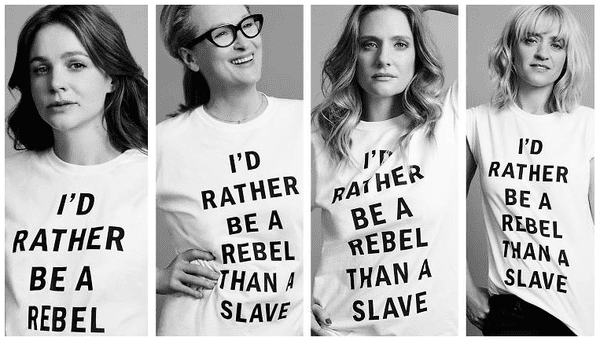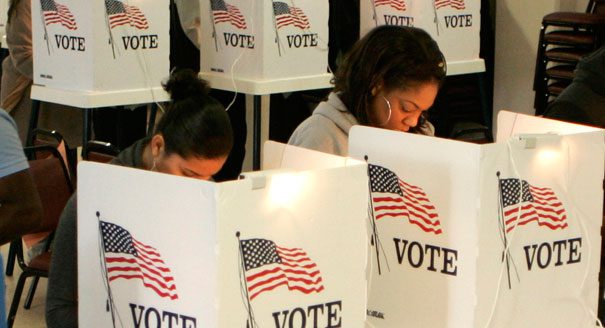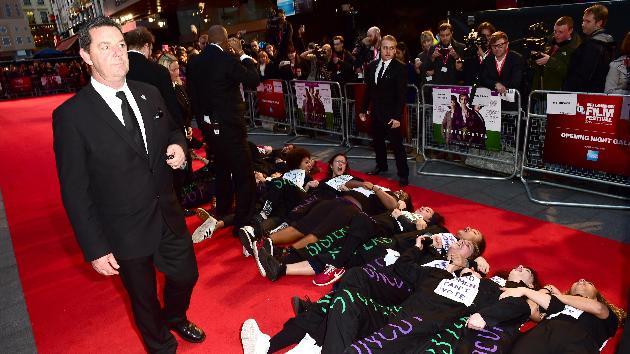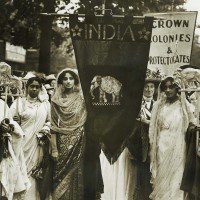Suffragette tells the story of the women’s suffrage movement in Britain during the early 1900s. In its telling of the story of how women fought for the right to vote, the movie highlights problems with the modern day feminist movement. Some of these current problems mirror those faced by the suffragettes at the dawn of the 20th century, while others show that feminists have taken steps backward since the days of the suffrage movement. The film Suffragette highlights the need for today’s feminists to correct the historic failures of feminism and identify as intersectional feminists, to defend the hard fought victories of our ancestors by actually exercising the power of the vote in order to advance the cause of feminism today, and to take direct action to support feminist causes.
A significant issue in the suffragette movement was its racist treatment of women of color. This continues to be a problem within mainstream feminism today. By ignoring women of color, Suffragette highlights the problem feminism had and still has with intersectionality. The movie’s absence of roles for women of color was addressed directly by the film’s director, Sarah Gavron. At a luncheon to honor the film, she leaned on historical accuracy to defend the lack of women of color in the film:
“We interrogated the written and photographic evidence, and the truth is, it’s very, very different picture from the US. The US had a lot of women of color involved in the movement, some who were excluded, and some who weren’t excluded.
But in the UK, it wasn’t like that, because we had pockets of immigration…it was later, around the war, around the fifties, that really the UK shifted and changed in a really wonderful way to produce what we have today,”
As Hanna Flint points out in “Suffragette is Good for White Feminism, Bad for Intersectionality,” not only were there many Indian suffragettes involved in the British movement, but many of the neighborhoods in the film were populated with African and Chinese immigrants, yet even the background characters in Suffragette are portrayed as white. As Ijeoma Oluo states in her piece “Why I Won’t Write a Review of Suffragette”:
“[T]here are no people of color in this movie. Not in the streets, not in the factories, not in the crowds. Nowhere. They don’t exist. The creators of this film took creative license to generate a whole new main character for the film, but they couldn’t come up with a single brown face in a crowd?”
It is distressing that the filmmakers continued the long history of erasing and ignoring women of color in the suffrage movement in the rendering of this film.
Suffrage pioneer Susan B. Anthony once made this horrifically racist statement:
“The old anti-slavery school says women must stand back and wait until the Negroes shall be recognized. But we say, if you will not give the whole loaf of suffrage to the entire people, give it to the most intelligent first. If intelligence, justice, and morality are to have precedence in the government, let the question of the woman be brought up first and that of the Negro last.”
Unfortunately, the practice of racist exclusion of women of color is not just part of feminist history; it continues to this day. In a photo intended to promote the film, several of its stars posed wearing a t-shirt that read “I’d Rather be a Rebel than a Slave.” The quote is from one of the leaders of the British suffragette movement, Emmeline Pankhurst, who is played by Streep in the film. The fact that four white women, including Meryl Streep, didn’t consider the racial insensitivity inherent in wearing such a shirt is white privilege run amok.
But Meryl Streep’s intersectionality issue is not the only problem of today’s feminism. Feminism is in the spotlight in a big way these days. Entertainers like Amy Schumer, Aziz Ansari, and Beyoncé all have brought new attention to feminism. Roxane Gay, Caitlin Moran, and Chimamanda Ngozi Adichie have reinvigorated the discussion of what it means to be feminist. Yet despite its renewed cultural relevance, there are still many who simply refuse to identify as a feminist. Count Meryl Streep amongst those ranks. When asked by Time Out if she was a feminist, Streep replied, “I am a humanist, I am for nice easy balance.” Why the reluctance to identify as a feminist? She has starred in many movies with strong feminist themes and given voice to feminist issues particularly within the entertainment community. Teo Bugbee points out in The Daily Beast, “Women like Meryl Streep are supposed to be our base, not our swing votes.” Too many people today support feminism’s ideals but continue to refuse to identify as such. We need everyone who is an intersectional feminist to identify as such to give strength and power to the cause, to show the power of intersectional feminists as a consumer and voting block, and to have power of influence both peer-to-peer and in consideration by the media. Identifying as an intersectional feminist is one of the most powerful things that each individual can do to support the twin causes of racial and gender justice. Neither one should be left behind.
Yet despite its renewed cultural relevance, there are still many who simply refuse to identify as a feminist. Count Meryl Streep amongst those ranks. When asked by Time Out if she was a feminist, Streep replied, “I am a humanist, I am for nice easy balance.” Why the reluctance to identify as a feminist? She has starred in many movies with strong feminist themes and given voice to feminist issues particularly within the entertainment community. Teo Bugbee points out in The Daily Beast, “Women like Meryl Streep are supposed to be our base, not our swing votes.” Too many people today support feminism’s ideals but continue to refuse to identify as such. We need everyone who is an intersectional feminist to identify as such to give strength and power to the cause, to show the power of intersectional feminists as a consumer and voting block, and to have power of influence both peer-to-peer and in consideration by the media. Identifying as an intersectional feminist is one of the most powerful things that each individual can do to support the twin causes of racial and gender justice. Neither one should be left behind.
While the suffragettes fought to the death for the right to vote, once voting rights were secured for white women, most 20th century suffragettes did not continue their work to ensure meaningful access to the franchise for African-American women, who were routinely denied the right to vote until the passage of the Voting Rights Act of 1965 began to pave the way in a struggle that remains to this day. All too often, white women secure rights for themselves and leave women of color behind. For instance, abortion and birth control are available to women who can afford to travel, comparison shop for health insurance, or pay out of pocket. However, the Hyde Amendment, religious exemptions to the Affordable Care Act, and new abortion legislation in the states all mean that access to abortion and birth control can be scarce and difficult for women without adequate resources. This disproportionally affects women of color. All too often the rights of women of color and the economically disadvantaged are ignored, if not outright sacrificed, in the name of progress for privileged white women.
 While identifying as an intersectional feminist is a crucial step, it is not enough to stop there. It is important to take that intersectionality to the voting booth. I wonder what the suffragettes would think about how many women turn out to vote today? Policy that regulates women’s lives—such as reproductive health policy, paid childcare, equal pay—is at play in every virtually every federal, state, and local election yet women routinely fail to vote. In the 2008 general election, 34.3% of eligible female voters failed to cast a vote. In the 2014 midterms, 57% failed to do so. These numbers are consistent with voting trends from election to election. Is it acceptable that anywhere from 1/3 to 3/5 of eligible women voters are not exercising their right to do so in federal elections, and even more so fail to do so in many state and local elections? Women were jailed, tortured, and died fighting for our right to vote and yet a third of eligible women still do not bother to go to the polls on election day, even in presidential general elections. Clearly we can do better. Perhaps we should remember the suffragettes and what they sacrificed the next time we think about skipping the polling booth.
While identifying as an intersectional feminist is a crucial step, it is not enough to stop there. It is important to take that intersectionality to the voting booth. I wonder what the suffragettes would think about how many women turn out to vote today? Policy that regulates women’s lives—such as reproductive health policy, paid childcare, equal pay—is at play in every virtually every federal, state, and local election yet women routinely fail to vote. In the 2008 general election, 34.3% of eligible female voters failed to cast a vote. In the 2014 midterms, 57% failed to do so. These numbers are consistent with voting trends from election to election. Is it acceptable that anywhere from 1/3 to 3/5 of eligible women voters are not exercising their right to do so in federal elections, and even more so fail to do so in many state and local elections? Women were jailed, tortured, and died fighting for our right to vote and yet a third of eligible women still do not bother to go to the polls on election day, even in presidential general elections. Clearly we can do better. Perhaps we should remember the suffragettes and what they sacrificed the next time we think about skipping the polling booth.
The suffragettes risked incarceration, forced feedings, and sometimes death in order to fight for a woman’s right to vote. These types of radical acts were necessary to jolt the establishment into changing policy and doing what was right. Radical action as a path to change is not unique to the fight for a women’s suffrage. The civil rights movement for African-American people, the women’s rights movement, and the AIDS funding crisis all made significant progress due to the radical action taken by people fighting for change. Where is our radical action today? There were protests at the London premiere of Suffragette where protesters barricaded the red carpet to call attention to cuts in domestic violence services. This juxtaposition of activism against the backdrop of Suffragette might serve as a reminder to each of us to get involved and take the kind of direct action that suffragettes engaged in.
Look at what the suffragettes risked to obtain the right to vote and compare it to what we risk today. I’m not suggesting that we need to engage in the modern day equivalent of suffragette tactics of blowing up mailboxes or stepping in front of charging horses, but don’t the modern day issues feminists are fighting for deserve their own radical action? Is equal pay less worthy of radical action than the right to vote? Is a woman’s right to control her own body less worthy? We all need to get involved. Each of us should plan our action, radical or otherwise. Feminism is a revolution, not a reform.
One important action that many of us can take is direct support of feminist organizations doing meaningful work. As Gloria Steinem said,”A feminist is what the dictionary says which is a person, male or female, who believes in the full social, economic, political equality of women and men—and I would say also acts on it.” Wouldn’t it be tremendous if each of us who was able chose to act on our feminism but getting involved with three organizations, making sure that at  least one of those group’s work is focused on women of color and at least one is focused on the global community of women and girls, with perhaps a third geared toward some particular passion of ours—sports programs for disabled girls, scholarship opportunities for young women, reproductive health care for underserved women of color, companion services for older lesbians, or whatever particular group speaks to our hearts. What if each of us donated time or money to Third Wave Fund or National Network of Abortion Funds or The Southern Coalition for Social Justice or Kiva or one of the thousands of other feminist organizations out there? There is little point in identifying as an intersectional feminist and supporting policy change if we take no action to make any of that change happen. Give what you can to effect the change you want to see in the world. Don’t we have an obligation to those that fought before us to continue the fight for those that will come after us? As Maya Angelou said, “Nothing will work unless you do.”
least one of those group’s work is focused on women of color and at least one is focused on the global community of women and girls, with perhaps a third geared toward some particular passion of ours—sports programs for disabled girls, scholarship opportunities for young women, reproductive health care for underserved women of color, companion services for older lesbians, or whatever particular group speaks to our hearts. What if each of us donated time or money to Third Wave Fund or National Network of Abortion Funds or The Southern Coalition for Social Justice or Kiva or one of the thousands of other feminist organizations out there? There is little point in identifying as an intersectional feminist and supporting policy change if we take no action to make any of that change happen. Give what you can to effect the change you want to see in the world. Don’t we have an obligation to those that fought before us to continue the fight for those that will come after us? As Maya Angelou said, “Nothing will work unless you do.”
Perhaps some will argue that Suffragette should be enjoyed and celebrated as a snapshot of a victory for women’s rights. I don’t think that is the case. Gaining the right to vote was an enormous victory for women and while we should all be grateful for women’s suffrage, I don’t think we should be glorify a movement stained by racism. Let us instead use the failures of the movement to guide us to intersectional feminism and the victories to inspire us both to utilize the right to vote won by the suffragists and to take direct action to create change for tomorrow. Let us examine “Suffragette” to find inspiration, motivation, and to ensure past mistakes are corrected, not repeated.
***
Image credits: Featured image, Image #2, Image #3, Image #4, image #5.





One response
people in the past couldn’t have known what we face today. they were probably doing their best. maybe the movie caused some women to reconsider their apathy.
Click here to subscribe today and leave your comment.